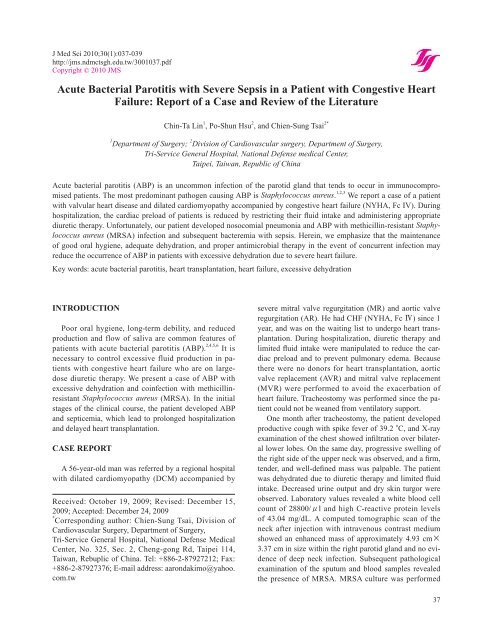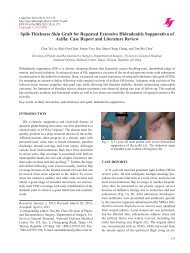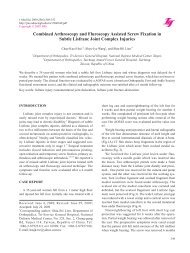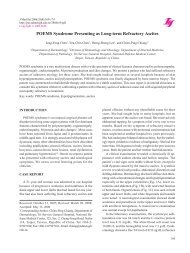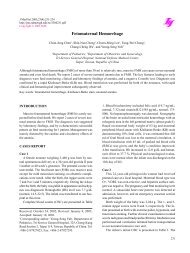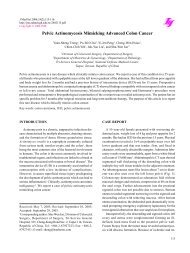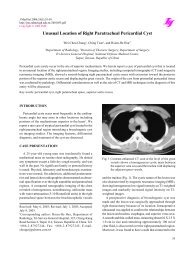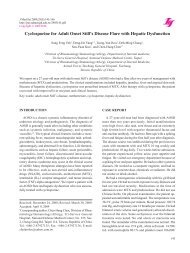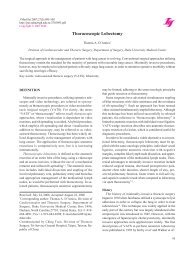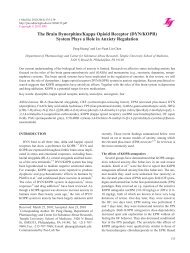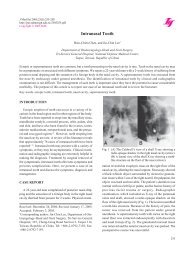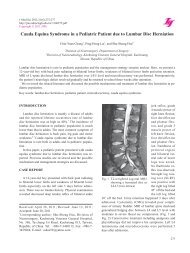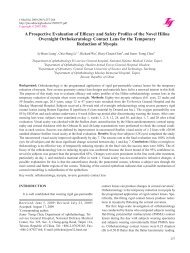Acute Bacterial Parotitis with Severe Sepsis in a Patient with ...
Acute Bacterial Parotitis with Severe Sepsis in a Patient with ...
Acute Bacterial Parotitis with Severe Sepsis in a Patient with ...
You also want an ePaper? Increase the reach of your titles
YUMPU automatically turns print PDFs into web optimized ePapers that Google loves.
J Med Sci 2010;30(1):037-039<br />
http://jms.ndmctsgh.edu.tw/3001037.pdf<br />
Copyright © 2010 JMS<br />
INTRODUCTION<br />
Poor oral hygiene, long-term debility, and reduced<br />
production and flow of saliva are common features of<br />
patients <strong>with</strong> acute bacterial parotitis (ABP). 2,4,5,6 It is<br />
necessary to control excessive fluid production <strong>in</strong> patients<br />
<strong>with</strong> congestive heart failure who are on largedose<br />
diuretic therapy. We present a case of ABP <strong>with</strong><br />
excessive dehydration and co<strong>in</strong>fection <strong>with</strong> methicill<strong>in</strong>resistant<br />
Staphylococcus aureus (MRSA). In the <strong>in</strong>itial<br />
stages of the cl<strong>in</strong>ical course, the patient developed ABP<br />
and septicemia, which lead to prolonged hospitalization<br />
and delayed heart transplantation.<br />
CASE REPORT<br />
A 56-year-old man was referred by a regional hospital<br />
<strong>with</strong> dilated cardiomyopathy (DCM) accompanied by<br />
Received: October 19, 2009; Revised: December 15,<br />
2009; Accepted: December 24, 2009<br />
* Correspond<strong>in</strong>g author: Chien-Sung Tsai, Division of<br />
Cardiovascular Surgery, Department of Surgery,<br />
Tri-Service General Hospital, National Defense Medical<br />
Center, No. 325, Sec. 2, Cheng-gong Rd, Taipei 114,<br />
Taiwan, Rebuplic of Ch<strong>in</strong>a. Tel: +886-2-87927212; Fax:<br />
+886-2-87927376; E-mail address: aarondakimo@yahoo.<br />
com.tw<br />
Ch<strong>in</strong>-Ta L<strong>in</strong>, et al.<br />
<strong>Acute</strong> <strong>Bacterial</strong> <strong>Parotitis</strong> <strong>with</strong> <strong>Severe</strong> <strong>Sepsis</strong> <strong>in</strong> a <strong>Patient</strong> <strong>with</strong> Congestive Heart<br />
Failure: Report of a Case and Review of the Literature<br />
Ch<strong>in</strong>-Ta L<strong>in</strong> 1 , Po-Shun Hsu 2 , and Chien-Sung Tsai 2*<br />
1 Department of Surgery; 2 Division of Cardiovascular surgery, Department of Surgery,<br />
Tri-Service General Hospital, National Defense medical Center,<br />
Taipei, Taiwan, Republic of Ch<strong>in</strong>a<br />
<strong>Acute</strong> bacterial parotitis (ABP) is an uncommon <strong>in</strong>fection of the parotid gland that tends to occur <strong>in</strong> immunocompromised<br />
patients. The most predom<strong>in</strong>ant pathogen caus<strong>in</strong>g ABP is Staphylococcus aureus. 1,2,3 We report a case of a patient<br />
<strong>with</strong> valvular heart disease and dilated cardiomyopathy accompanied by congestive heart failure (NYHA, Fc IV). Dur<strong>in</strong>g<br />
hospitalization, the cardiac preload of patients is reduced by restrict<strong>in</strong>g their uid <strong>in</strong>take and adm<strong>in</strong>ister<strong>in</strong>g appropriate<br />
diuretic therapy. Unfortunately, our patient developed nosocomial pneumonia and ABP <strong>with</strong> methicill<strong>in</strong>-resistant Staphylococcus<br />
aureus (MRSA) <strong>in</strong>fection and subsequent bacteremia <strong>with</strong> sepsis. Here<strong>in</strong>, we emphasize that the ma<strong>in</strong>tenance<br />
of good oral hygiene, adequate dehydration, and proper antimicrobial therapy <strong>in</strong> the event of concurrent <strong>in</strong>fection may<br />
reduce the occurrence of ABP <strong>in</strong> patients <strong>with</strong> excessive dehydration due to severe heart failure.<br />
Key words: acute bacterial parotitis, heart transplantation, heart failure, excessive dehydration<br />
severe mitral valve regurgitation (MR) and aortic valve<br />
regurgitation (AR). He had CHF (NYHA, Fc ) s<strong>in</strong>ce 1<br />
year, and was on the wait<strong>in</strong>g list to undergo heart transplantation.<br />
Dur<strong>in</strong>g hospitalization, diuretic therapy and<br />
limited uid <strong>in</strong>take were manipulated to reduce the cardiac<br />
preload and to prevent pulmonary edema. Because<br />
there were no donors for heart transplantation, aortic<br />
valve replacement (AVR) and mitral valve replacement<br />
(MVR) were performed to avoid the exacerbation of<br />
heart failure. Tracheostomy was performed s<strong>in</strong>ce the patient<br />
could not be weaned from ventilatory support.<br />
One month after tracheostomy, the patient developed<br />
productive cough <strong>with</strong> spike fever of 39.2 o C, and X-ray<br />
exam<strong>in</strong>ation of the chest showed <strong>in</strong>ltration over bilateral<br />
lower lobes. On the same day, progressive swell<strong>in</strong>g of<br />
the right side of the upper neck was observed, and a rm,<br />
tender, and well-dened mass was palpable. The patient<br />
was dehydrated due to diuretic therapy and limited uid<br />
<strong>in</strong>take. Decreased ur<strong>in</strong>e output and dry sk<strong>in</strong> turgor were<br />
observed. Laboratory values revealed a white blood cell<br />
count of 28800/l and high C-reactive prote<strong>in</strong> levels<br />
of 43.04 mg/dL. A computed tomographic scan of the<br />
neck after <strong>in</strong>jection <strong>with</strong> <strong>in</strong>travenous contrast medium<br />
showed an enhanced mass of approximately 4.93 cm<br />
3.37 cm <strong>in</strong> size <strong>with</strong><strong>in</strong> the right parotid gland and no evidence<br />
of deep neck <strong>in</strong>fection. Subsequent pathological<br />
exam<strong>in</strong>ation of the sputum and blood samples revealed<br />
the presence of MRSA. MRSA culture was performed<br />
37
ABP before heart transplantation<br />
Fig. 1 The right parotid gland shows diffuse enlargement<br />
<strong>with</strong> slight <strong>in</strong>crease <strong>in</strong> parenchyma enhancement (the<br />
arrow) as compared to the left normal-sized parotid.<br />
us<strong>in</strong>g samples obta<strong>in</strong>ed by f<strong>in</strong>e-needle aspiration and<br />
from <strong>in</strong>fected tissue specimens. Adequate hydration and<br />
adm<strong>in</strong>istration of parent eral antimicrobials, <strong>in</strong>clud<strong>in</strong>g<br />
vancomyc<strong>in</strong> and ertapenem, was performed. After 2<br />
weeks of antibiotic treatment <strong>with</strong> <strong>in</strong>travenous vancomyc<strong>in</strong><br />
<strong>in</strong>jection, ABP-associated MRSA <strong>in</strong>fection and nosocomial<br />
pneumonia were completely resolved as <strong>in</strong>dicated<br />
by MRSA-negative blood and sputum culture. Further,<br />
laboratory values revealed a white blood cell count of<br />
7600/l and C-reactive prote<strong>in</strong> level of 0.4 mg/dL. After<br />
2 weeks, the patient underwent heart transplantation, and<br />
subsequently, he was discharged <strong>in</strong> a stable condition <strong>in</strong><br />
the next 2 weeks.<br />
DISCUSSION<br />
Parotid <strong>in</strong>fection is the most common form of salivary<br />
gland <strong>in</strong>fection, and Staphylococcus aureus is the most<br />
common pathogen observed <strong>in</strong> the nosocomial cases. 1,2,3<br />
ABP, characterized by the sudden onset of a unilateral<br />
and tender swell<strong>in</strong>g on the face or neck, probably orig<strong>in</strong>ates<br />
from a septic focus <strong>in</strong> the oral cavity or respiratory<br />
tract; similar f<strong>in</strong>d<strong>in</strong>gs were observed <strong>in</strong> our case.<br />
ABP is commonly observed <strong>in</strong> debilitated patients who<br />
develop systematic illness on account of recent surgery,<br />
immunosuppression, advanced age, and chemotherapy,<br />
38<br />
Fig. 2 The size of the right parotid is measured 4.93 cm <strong>in</strong><br />
anterior-posterior diameter and 3.37 cm <strong>in</strong> width on<br />
axial plane (the arrow). The normal left parotid is<br />
about 3.782.8 cm 2 .<br />
which could be life-threaten<strong>in</strong>g (mortality rate, more than<br />
50%). 4,7,8,9 The ma<strong>in</strong> risk factor is decreased salivation,<br />
which is a predisposition to the overgrowth of bacteria. 4<br />
Moreover, ABP can result from other conditions such as<br />
Sjogren’s syndrome, diabetes mellitus, hepatic failure,<br />
renal failure, hypothyroidism, Cush<strong>in</strong>g’s disease, and due<br />
to dehydration caused by the antichol<strong>in</strong>ergic and diuretic<br />
effects of medications such as antihypertensives, antihistam<strong>in</strong>es,<br />
and antidepressants. 10 Numerous factors are<br />
associated <strong>with</strong> salivary stasis and <strong>in</strong>creased risk of acute<br />
suppurative <strong>in</strong>fection of the salivary gland. Systemic<br />
dehydration is the mian classic cause of salivary stasis<br />
<strong>in</strong> postoperative patients or those who have undergone<br />
medical therapy <strong>in</strong>clud<strong>in</strong>g diuretics and are on limited<br />
uid <strong>in</strong>take. 5 In 78% of the cases, the fundamental treatment<br />
was antibiotic therapy <strong>with</strong>out dra<strong>in</strong>age. The antibiotic<br />
treatment should be started immediately after diagnosis,<br />
and surgical dra<strong>in</strong>age should be performed only<br />
if obvious cl<strong>in</strong>ical improvement is not observed <strong>with</strong><strong>in</strong><br />
48h. 11,12,13,14,15 .<br />
In our case, the patient had valvular heart disease<br />
and dilated cardiomyopathy <strong>with</strong> CHF accompanied by<br />
MRSA nosocomial pneumonia. Therefore, we highly<br />
suspected that ABP resulted from MRSA pneumonia<br />
that was caused by either spread<strong>in</strong>g of the sputum <strong>in</strong> the<br />
lower respiratory tract due to <strong>in</strong>appropriate suction or by
the normal ora <strong>in</strong> the oral cavity. The colonization of<br />
MRSA via Stensen’s duct might occur due to poor oral<br />
hygiene and decreased production and flow of saliva<br />
from the parotid gland. 5,6 In patients <strong>with</strong> CHF, diuretic<br />
adm<strong>in</strong>istration was the standard treatment to decrease the<br />
cardiac preload. However, excessive dehydration was associated<br />
<strong>with</strong> <strong>in</strong>creased <strong>in</strong>cidence of ABP. Eventually, the<br />
patient underwent heart transplantation and no recurrent<br />
ABP was observed when the patient was <strong>in</strong> an immunocompromised<br />
state dur<strong>in</strong>g the late cl<strong>in</strong>ical course. The<br />
nd<strong>in</strong>gs of our case highlight the importance of ABP as<br />
a potential life-threaten<strong>in</strong>g complication <strong>in</strong> patients who<br />
are adm<strong>in</strong>istered large-dose diuretic therapy, especially<br />
those <strong>with</strong> severe CHF. Our patient recovered successfully<br />
after 2 full- courses of vancomyc<strong>in</strong> therapy, and<br />
he underwent heart transplantation 2 weeks later. It is<br />
important that, oral hygiene, even regular gargl<strong>in</strong>g, be<br />
emphasized <strong>in</strong> <strong>in</strong>tensive care units. Moreover, wash<strong>in</strong>g<br />
hands after exam<strong>in</strong><strong>in</strong>g patients and us<strong>in</strong>g different suction<br />
tubes for both lower respiratory tract and oral cavity<br />
can avoid iatrogenic MRSA <strong>in</strong>fection.<br />
REFERENCES<br />
1. Brook I, Frazier EH, Thompson DH: Aerobic and anaerobic<br />
microbiology of acute suppurative parotitis.<br />
Laryngoscope. 1991;101:170-172.<br />
2. Brook I. <strong>Acute</strong> bacterial suppurative parotitis: microbiology<br />
and management, J. Craniofac. Surg.<br />
2003;14:37-40.<br />
3. Ganesh R., Leese T. Parotid abscess <strong>in</strong> S<strong>in</strong>gapore.<br />
S<strong>in</strong>gapore Med. J. 2005;46:553-556.<br />
4. Srirompotong S, Saeng-Sa-Ard S. <strong>Acute</strong> suppurative<br />
parotitis. J Med Assoc Thai 2004;87:694-6.<br />
Ch<strong>in</strong>-Ta L<strong>in</strong>, et al.<br />
5. Shelly JM. <strong>Acute</strong> viral and bacterial <strong>in</strong>fection of the<br />
salivary glands. Otolaryngologic Cl<strong>in</strong>ics of North<br />
America. 1999;32:793-809.<br />
6. Nawaf AD, Susan HW. Cervical lymphadenitis, suppurative<br />
parotitis, thyroiditis, and <strong>in</strong>fected cysts. Infect<br />
Dis Cl<strong>in</strong> N Am. 2007;21:523-541.<br />
7. Hilda J, Sandr<strong>in</strong>e S, Dragoslav M, Marianne B, Evelyne<br />
F, Anne-marie LH. Occurrence of suppurative<br />
parotitis <strong>in</strong> elderly people rema<strong>in</strong>s a bad omen. J Am<br />
Geriatr Soc. 2008;56:760-1.<br />
8. Raad II, Sabbagh MF, Caranasos GJ: <strong>Acute</strong> bacterial<br />
sialadenitis: a study of 29 cases and review. Rev Infect<br />
Dis. 1990;12:591-601.<br />
9. Knepil GJ, Fabbroni G, A life-threaten<strong>in</strong>g complication<br />
of acute parotitis, Br J Oral Maxillofac Surg.<br />
2008;46:328-9.<br />
10. Dale HR. Non<strong>in</strong>ammatory, non-neoplastic disorders<br />
of the salivary glands. Otolaryngologic Cl<strong>in</strong>ics of<br />
North America. 1999;32:835-42.<br />
11. Salaria M, Poddar B, Parmar V. Neonatal parotitis.<br />
Indian J Pediat.2001;68:283<br />
12. Brook I. Suppurative parotitis caused by anaerobic<br />
bacteria <strong>in</strong> newborns. Pediatr Infect Dis J.<br />
2002;21:81-2.<br />
13. Riitta TS, Kaija LK, Anne PR. Cases present<strong>in</strong>g as<br />
parotid abscesses <strong>in</strong> children. International Journal of<br />
Pediatric Otorh<strong>in</strong>olaryngology. 2007;71:897-901<br />
14. Sabat<strong>in</strong>o G, Verrotti A, de Mart<strong>in</strong>o M. Neonatal suppurative<br />
parotitis: a study of ve cases. Eur J Pediatr.<br />
1999;158:312-14.<br />
15. Mariell J, Susan B. Heart Failure. N Engl J Med.<br />
2003;348:2007-2018.<br />
39


